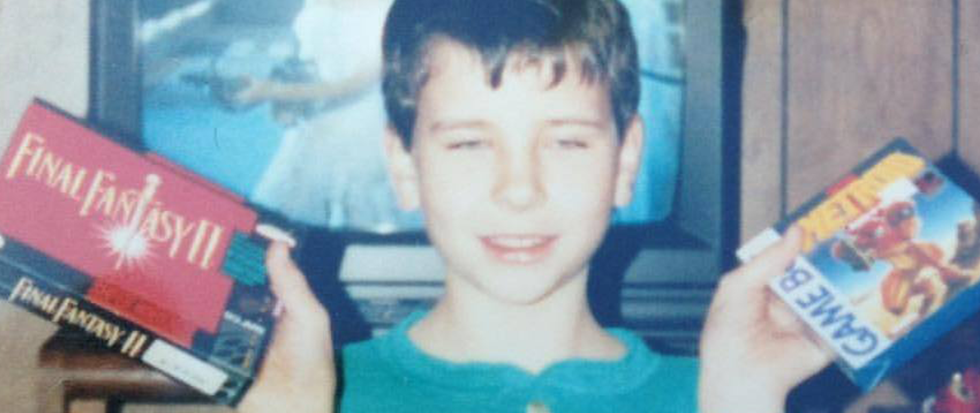
Your Spoony Speedrunner
My collection of Christmas photos is not exactly extensive. But there’s one I’ll always treasure, in regular rotation as my social media profile photo: young me in pine green long johns, Spaceballs on pause in the background, waving copies of Metroid II and Final Fantasy II. If you are familiar with the Final Fantasy franchise, you probably know this entry in its official Japanese capacity as Final Fantasy IV, or the one that coined the delightful faux-Shakespearean insult “You spoony bard!”
Final Fantasy IV was the first role-playing videogame to burrow into my brain, and as such, my attachment to it goes beyond logic or cold critical remove. I’ve played its 25+ hours more than I’ve read my favorite books, beating Zeromus several times and investing myself deeply in redemptive headcanon for resident edgelord Kain. The game’s music soundtracks most of the D&D sessions I administer, and Yoshitaka Amano’s artwork set the aesthetic standard for my mind’s eye while reading fantasy for years. I’ve loved this game for decades, but after watching a speedrun of Final Fantasy IV from this past season of the Awesome Games Done Quick charity stream, it’s clear that this game fascinates other players for wildly different reasons, no matter how similar the roots of our appreciation are.
Despite my best efforts to avoid aging and shaking my fist at cloud, I’m old and out of touch in many ways. But even I’m familiar with the concept of speedrunning. Videogame players rush to finish games as fast as they can, investigating and crowdsourcing various tricks, tips, and glitches until they whittle a title well past the original intentions and approach it more as a complex meta-puzzle. Eventually speedrunners peel back the layers of theater and artifice in which the designers swaddled their code to reveal all manner of checksum obfuscation, buffer overflows, memory management, and other computer science/cyberpunk lexicology that I can only play lip service to.
This dissection of the intricate programmatic nexus of even the most primitive games was not an element of speedrunning that I’d ever really considered before watching this stream, which I only loaded up because of my affinity for the game. And while the Final Fantasy IV I cherish was present for most of this roughly two-and-a-quarter hour jaunt, it was manhandled into something near unrecognizable. Every aspect of the game as sold, from equipment to monster battles through the main plot and textual dialogue, are seen as the true barriers to greatness.
The obstacles to be overcome in a speedrun of Final Fantasy IV are not what the purchased product offers on silver, but rather every component of the “game” that stands between the runner and her final time. This means avoiding and running from random battles wholecloth, managing items via obscure menu-based abacus algorithms to duplicate equipment to sell and steal monster abilities never meant to be deployed by our heroes, all in order to strike down fearsome bosses in a few measly attacks. The majority of the first half of this epic tale is just slashed through with the A button mashed throughout all conversation, because the script is quicksand for the speedrunner, the characters simply pieces on a board meant to be operated at precise intervals to maximize distance covered and mechanics sidestepped.
As the AGDQ player is going along, he jokes about beloved characters who will never appear in this stream. “Ninja? What Ninja?” and “Why’s Cid here on the moon?” My childhood friends reduced to the mere shadows of an inside joke, discarded to the cutting room floor in service of shedding hours. Of course this culminates in an anticlimax, when the fearsome puppetmaster we normally only learn about shortly before the final grueling dungeon-crawl (Final Fantasy IV is precious to me, but I can still see its Jungian flaws) is obliterated in one attack summoned via a dizzyingly obtuse series of menu manipulations. The speedrunners cast their own mesmerizing spell within the math of the game to immolate one of the most fearsome enemies, summoning the credits and wrapping up their endurance run.
To watch Final Fantasy IV get flayed so fluently, with a mind-boggling grace not unlike a stolen car getting stripped for parts in seconds, was quite disorienting at first. Once the illusion is cracked, the rest of the scaffolding the game as I always knew it sheds more quickly, until Cecil is in the dwarven castle running up and down the stairs more than sixty times in order to trick the computer into warping the party into a fractured ethereal plane, leading them to the endgame tens of hours early. The curtain is pulled away and perhaps for the first time I see Final Fantasy IV for what it really is—cobbled code buttressing an intricate Rube Goldberg theatrical production, and these speedrunning wizards have turned it into Act 2 of Noises Off where we see the play behind the play.
AGDQ weren’t winding through my Final Fantasy IV anymore. To get to this point they clearly were keen on every cranny of this game’s surface as I’d ever been and more, and found new excuses and methods for investigating further. They kneaded the numbers behind the numbers until they could bend the entire world to their whims. It’s astounding, if a little bewildering. But at the same time, I’m inspired to fire up my PSP once again and rekindle my own childhood’s elaborate preoccupations. We’re all thirsty for that old desire to embrace a captivating world as fully and completely as possible, wherever we may find it.





